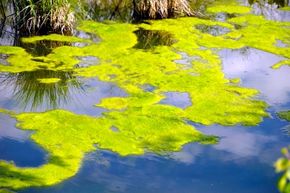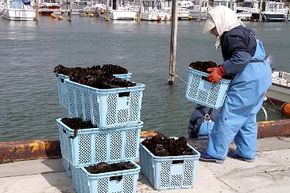When is a weed not a weed? The simple answer is: when it's seaweed. Today, algae -- which can take the form of a water-borne weed or ordinary pond scum -- holds immense promise for supplying us with everything from animal feed to jet fuel.
Algaculture is the commercial cultivation of algae. Algae (the singular is "alga," Latin for "seaweed," but you'll rarely find just one) are simple green plants that grow in water. Their green color means they produce their own food using photosynthesis, just like grass, trees and corn. Algae come in two main forms. Macroalgae are seaweeds. Kelp grows to more than 180 feet (55 meters) long in the ocean [source: Edwards]. Nori is the variety you'll find wrapped around your sushi. Microalgae are tiny, single-celled plants that float in the water, each one visible only through a microscope.
Advertisement
Algaculture is nothing new. Seaweed was first cultivated in Japan at least 1,500 years ago and algae production is still a big business there [source: Guiry]. Dulse has long been eaten in the British Isles and the microalgae spirulina were harvested by the Aztecs of 16th-century Mexico. In addition to providing human food, seaweeds have been used for fertilizers. They provide the food thickener carrageen and other gelling agents and stabilizers that show up in everything from soup to toothpaste. Worldwide, algae production is a $6 billion business [source: Food and Agriculture Organization of the United Nations].
Today, algae are attracting new interest and resarch investment because of their potential to provide energy and combat environmental threats. Part of the organic mass of algae takes the form of oil, which can be squeezed out and converted to biodiesel fuel. Algae beat land plants hands down in the efficiency with which they produce oil. Some varieties of algae yield an oil that can be refined into gasoline and even jet fuel. The carbohydrate portion of the plants can be fermented for ethanol production.
Algae can convert waste carbon dioxide, a greenhouse gas that pours from smokestacks, to usable products. They can help clean dirty water, converting pollutants to biomass. They have additional uses in pharmaceuticals and cosmetics.
With all this potential, this "weed" certainly seems to deserve a closer look.
Advertisement


